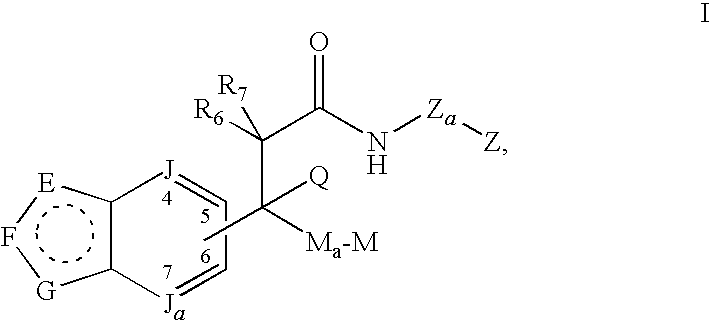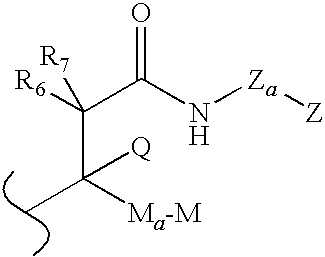Modulators of glucocorticoid receptor, AP-1, and/or NF-κB activity and use thereof
a technology of glucocorticoid receptor and ap-1, which is applied in the field of new nonsteroidal compounds, can solve the problems of limited systemic use of glucocorticoid receptors
- Summary
- Abstract
- Description
- Claims
- Application Information
AI Technical Summary
Benefits of technology
Problems solved by technology
Method used
Image
Examples
example 1
3-(1-(4-Fluorophenyl)-1H-indazol-5-yl)-2,2-dimethyl-3-phenyl-N-(thiazol-2-yl)propanamide
[0388]
[0389]The procedure of Scheme A was used in preparing the Example 1 compound.[0390](a) Following the general procedure of Sun et al. (J. Org. Chem., 62:5627-5629 (1997)), 4-amino-3-methyl-benzyl alcohol (36.8 g, 269 mmol) was dissolved in dry chloroform (1 L) followed by potassium acetate (53 g, 540 mmol), and acetic anhydride (83 g, 810 mmol). After 2 h, the reaction was refluxed for 3 h and then cooled to rt and stirred overnight.[0391](b) The next day, 18-crown-6 ether (3.6 g, 13.5 mmol) was added followed by isoamyl nitrite (71.3 g, 608 mmol). The reaction was refluxed for 20 h, cooled to rt, washed with sat NaHCO3, and the organic layer was dried over MgSO4, filtered, and concentrated in vacuo. The crude oil was passed through a SiO2 plug first with 5% EtOAc in hexanes, then 20% EtOAc in hexanes and concentrated. The residue was triturated with Et2O / hexane to obtain 23.3 g of solid, bi...
examples 2 to 28
[0399]Following a procedure similar to that set out in Scheme A and Example 1, the following compounds were obtained.
[0400]
(M +H)+ / se-Coup-lec-lingtedMeth-Ex.NameProduct StructureAmineNMRod23-(1-(4-fluoro-phenyl)-1H- indazol-5-yl)-2,2-dimethyl- 3-phenyl-N-(1,3,4- thiadiazol-2- yl)propanamide(M − H)− 470A400 MHz 1H-NMR (DMSO-d6) δ 12.5 (s, 1 H); 9.09 (s, 1 H); 8.36 (s, 1 H); 7.92 (s, 1 H); 7.77 (dd,2 H); 7.68 (d, 1 H); 7.41 (m, 5 H); 7.27 (app t, 2 H); 7.19 (app t, 1 H); 5.07 (s, 1 H); 1.36 (s, 6 H).3N-cyclopentyl-3-(1-(4- fluorophenyl)-1H-indazol- 5-yl)-2,2-dimethyl-3- phenylpropanamide456A43-(1-(4-fluorophenyl)-1H- indazol-5-yl)-2,2-dimethyl- N-(1-methyl-1H-pyrazol-3- yl)-3-phenylpropanamide468BNMR (CDCl3) δ 8.05 (s, 1 H); 7.76 (s, 1 H) 7.5-7.6 (m, 2 H); 7.4-7.45 (d, 1 H); 7.28-7.4 (m, 4 H);7.1-7.26 (m, 5 H); 6.70 (d, 1 H); 4.63 (s, 1 H); 3.73 (s, 3 H); 1.36 (s, 3 H); 1.33 (s, 3 H).53-(1-(4-fluorophenyl)-1H- indazol-5-yl)-2,2-dimethyl- N-(methylsulfonyl)-3- phenylpropanamideMeSO2NH...
example 29
3-(1H-Indazol-5-yl)-2,2-dimethyl-3-phenyl-N-(thiazol-2-yl)propanamide
[0402]
[0403]The procedure of Scheme B was used in preparing the Example 29 compound.[0404](a) (1H-Indazol-5-yl)methanol (17.3 g, 117 mmol) from experimental (1c) was dissolved in 1 L dry DCM and Dess-Martin periodinane (53 g, 125 mmol) was added portionwise and the reaction was stirred overnight. The next day, the reaction was extracted with 1 M NaOH×3. The aqueous layers were pooled and extracted with EtOAc×5. The combined organic layers were dried over MgSO4, filtered, concentrated in vacuo to give 14.1 g (82% yield) of yellow solid 1H-indazole-5-carbaldehyde. MS found: (M+H)+=147.[0405](b) To a solution of 1H-indazole-5-carboxaldehyde (28 g, 200 mmol) and TMEDA (2 m mL) in 1 L of THF was added a solution of 1.0M phenylmagnesium bromide in THF (800 mmol) dropwise. After 3 days, the reaction was quenched with sat. NaCl and extracted with 3×EtOAc. The EtOAc extracts were dried over MgSO4, filtered, concentrated by ...
PUM
| Property | Measurement | Unit |
|---|---|---|
| pH | aaaaa | aaaaa |
| retention time | aaaaa | aaaaa |
| retention time | aaaaa | aaaaa |
Abstract
Description
Claims
Application Information
 Login to View More
Login to View More - R&D
- Intellectual Property
- Life Sciences
- Materials
- Tech Scout
- Unparalleled Data Quality
- Higher Quality Content
- 60% Fewer Hallucinations
Browse by: Latest US Patents, China's latest patents, Technical Efficacy Thesaurus, Application Domain, Technology Topic, Popular Technical Reports.
© 2025 PatSnap. All rights reserved.Legal|Privacy policy|Modern Slavery Act Transparency Statement|Sitemap|About US| Contact US: help@patsnap.com



